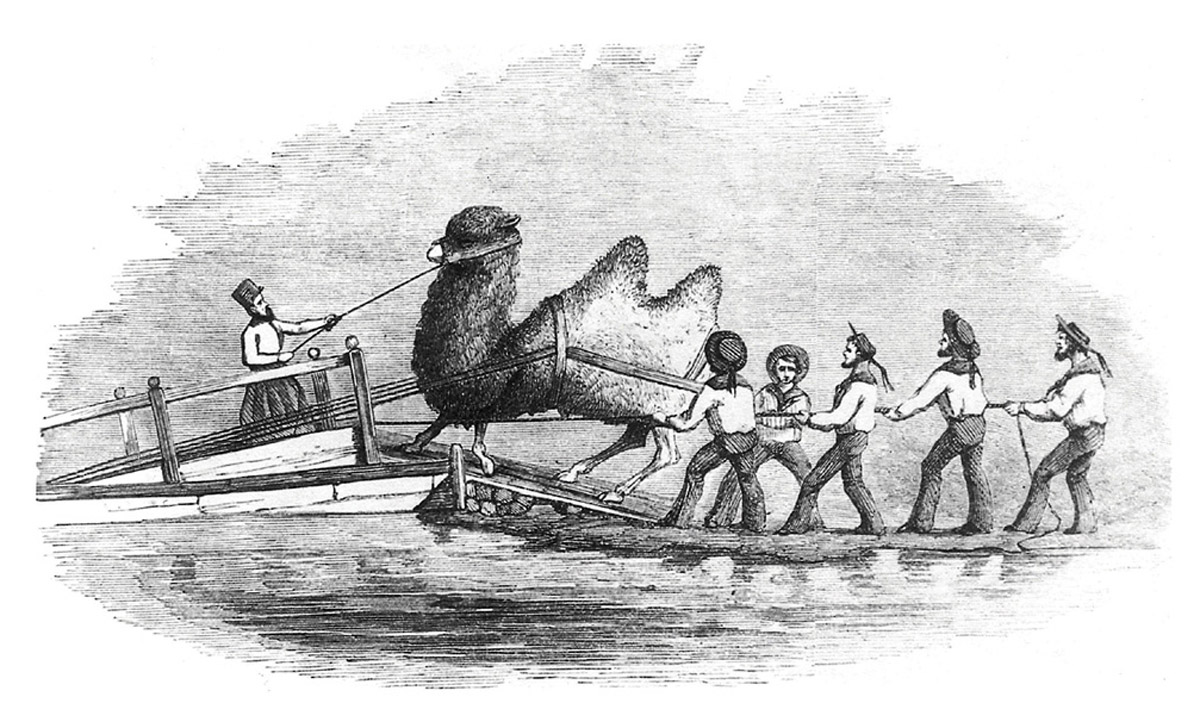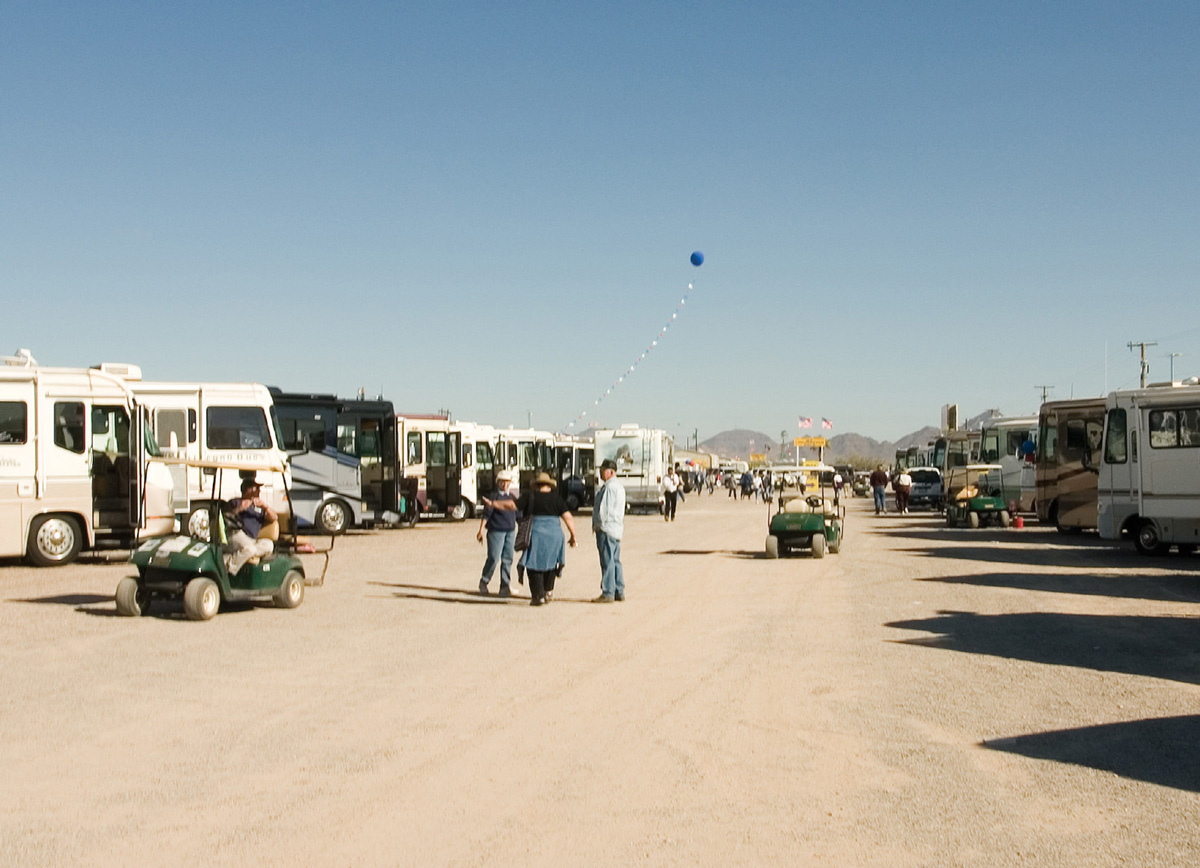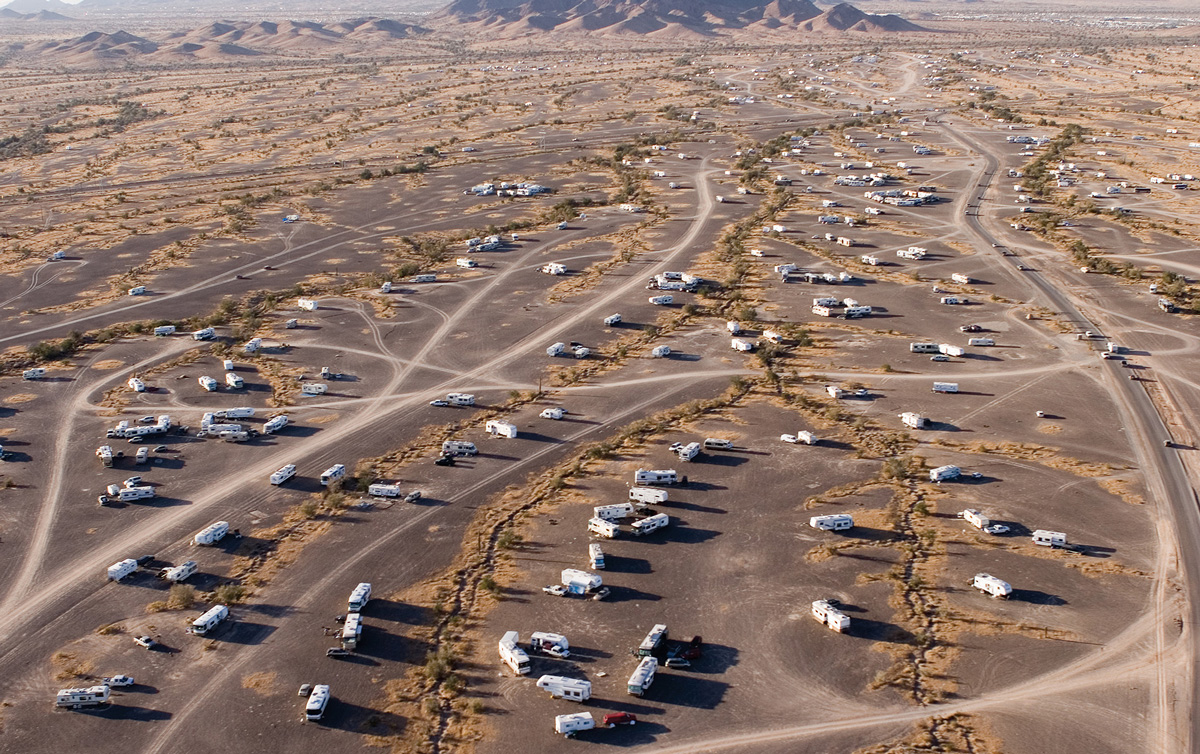Tales of Desert Nomads
Quartzsite’s long strange trip
AUDC (Robert Sumrell & Kazys Varnelis)

One of the least-known facts about the Mexican-American War of 1846–1848 is that it gave rise to the short-lived experiment of the United States Camel Corps. That conflict made clear to military leaders that securing the rough terrain of the Southwest against Native Americans or the Mexican government, both of whom were unhappy with the growing power of the US in that region, would not be easy. The majority of American causalities in the war in those distant lands fell victim not to enemy fire but to the harsh conditions, proving just how inhospitable that region is to traditional cavalry and infantry.
Convinced they had found a solution, Second Lieutenant George H. Crossman, a veteran of the Seminole Wars, and Major Henry C. Wayne, a quartermaster, gained the support of Secretary of War Jefferson Davis and persuaded Congress to allocate thirty thousand dollars to the Camel Military Corps in 1855. Like many such ideas, this seemed sensible at the time. Both Arabia and the American Southwest are similar climatologically. Obviously, dromedaries are well suited to the arid environment and even if it is hardly plausible that Crossman, Wayne, or Davis would have known this, giant prehistoric camels once roamed the American continent. More likely, Crossman and Davis had heard of plans to bring camels to the Mojave desert as pack animals and might even have received word that the animals were being brought to Australia by settlers to help colonize the Outback. In what would be the first operational test of material in the field by the Army, the Corps was charged with determining the capabilities of the animals for the possible formation of a camel cavalry, for deployment in artillery units, and for use as pack animals.
Two years later, the Army imported seventy-seven North African camels and a Syrian camel driver named Hadji Ali to the Southwest. Based at Camp Verde, the Corps was charged with establishing mail and supply routes to California to the west and to Texas to the east. Although the camels thrived in conditions that would fell any horse, the experiment was not without its problems. The animals did not adapt well to the rocky terrain, they scared other pack animals such as horses and burros, and soldiers found them foul-smelling and bad-tempered and complained about camels spitting at them. Nevertheless, the new Secretary of War, John Floyd, was impressed and asked Congress for a further one thousand camels. But tensions between the North and South were rising and the Congress couldn’t be bothered with the distant lands of the Southwest. Moreover, upon being appointed Commander of the Texas Army, Major General David E. Twiggs, sometimes known as “The Horse” (but also as “Old Davy” or “the Bengal Tiger”) was horrified to discover the Camel Corps in his charge and successfully lobbied Congress to be rid of the beasts. Perhaps it is just as well: Twiggs would soon surrender his command and, with it, the Texas Army to the Confederacy.
Instead of serving the Confederacy, the Camel Corps was sold off at auction in 1863. Most would wind up in private hands, but some would be released into the desert where they became feral. Hadji Ali, now known as “Hi Jolly,” remained behind although whether this was to pursue the American dream or simply because he was marooned far from home is unclear. After running a camel-borne freight business for a while, Hi Jolly married a Tucson woman and moved to the western Arizona town of Tyson’s Wells, nine miles west of Quartzsite, where he worked as a miner until he died in 1902. In memory of his service, the government of Arizona built a small pyramid topped by a metal camel on his gravesite in the 1930s. Feral camels would be seen roaming the desert until the early 1900s.
More recently, a new monument to the camel sprung up about a mile away, this time made of automobile rims and mufflers, to announce the fulfillment of the century-and-a-half-old vision of self-sufficient desert nomads roaming the West.
During the scorching summer, Quartzsite is a sleepy town of 3,397 inhabitants, but every year between October and March, a new breed of nomad comes to descend upon the town as hundreds of thousands of campers bring their Recreational Vehicles (RVs) to Quartzsite. These “snowbirds,” generally retirees from colder climates, settle in one of the more than seventy RV parks in the area or in the outlying desert administered by the Bureau of Land Management (BLM). The BLM and local law enforcement agencies estimate that a total of 1.5 million people spend time in Quartzsite between October and March, a mass migration that temporarily forms one of the fifteen largest cities in the United States. If all of these residents inhabited Quartzsite at once, the result would be a more populous urbanized area than Dallas, San Jose, or San Diego, possibly even bigger than Phoenix or Philadelphia, America’s fifth largest city.
For a half century after Hi Jolly’s death, the population of Quartzsite remained small, with only about fifty people living in the outpost town on a permanent basis. By the 1950s, however, snowbirds began spending the relatively mild winter months in the area, and by the 1960s the seasonal population would swell to 1,500. Many of these winter travelers returned year after year and some settled permanently. As the community slowly grew, businessmen and civic boosters formed the Quartzsite Improvement Association and created a gem and mineral show to encourage more winter travelers to come.
Today, Quartzsite makes a radical break with the surrounding emptiness. Although it rejects vertical density and permanence, Quartzsite proposes a new kind of super-dense sprawl, achieving a remarkable horizontal density as RV is parked next to RV.

That they came at all is the result of the invention of this modern replacement for Hi Jolly’s camels—the RV. In retrospect, the development of such a self-sufficient beast, capable of hauling a family and enough food and water to sustain it long distances, seems almost inevitable.
In his 1896 essay “The Frontier in American History,” Frederick Jackson Turner, the founder of American Studies, observed that the United States Census Bureau considered the frontier closed in the 1880s. For Jackson, this could only result in an epochal shift in the American psyche. Until then, he argued, Americans could renew themselves in the primitive conditions of the frontier. The loss of a true wilderness experience meant that the individual no longer had a ready place for social regeneration.
The end of social regeneration on the frontier, however, paved the way for a new idea: recreation in exurbia. After Henry Ford built the Model T, his “car for the great multitude,” large numbers of individuals would flee the city on a regular basis in search of the newly domesticated “nature.” Ford himself believed that the Model T’s principal use would be to enable families to enjoy the blessing of hours of pleasure in God’s great open space. Auto camping grew rapidly after World War I. By 1922, the New York Times estimated that of 10.8 million cars, 5 million were in use for camping. Soon “auto-tents” designed to fit the Model T would be available and trailers for the Model T to tow would follow.
At first, campers would simply park in empty fields or by the side of the road, but this led to confrontations with angry rural townsfolk, who saw their lives under threat not only from declining profitability but also from these nascent exurbanites who they feared would one day colonize the countryside. Soon campgrounds or “trailer parks” sprang up to provide places to stay with other campers on the road. Although campers sought nature and escape from a fixed community, they also enjoyed sharing this experience with their brethren. Unlike the metropolis, trailer parks were places of relative homogeneity—campers were generally middle-class WASPs—so campers were able to tolerate living in remarkably close quarters.
During the Depression and World War II, camper trailers acquired a stigma, coming to be used as temporary shelters to be inhabited while their inhabitants worked transient jobs. With the return of affluence in the 1950s, however, Americans once again regained their desire to travel the country in self-sufficient “land yachts,” untethered by hotels, inns, or motor courts. By this point, the old automobile-drawn campers were unsuitable. Not only did they have the unpleasant connotation of transient housing to overcome, but they now also seemed small and cramped given the increase in the size of homes in suburbia.
The solution was to integrate the automobile and the trailer, creating the continuous unit now known as the “Motorhome” or “Recreational Vehicle.” This new kind of vehicle was generally much larger than the campers of old and it would permit other activities to take place while the unit was being driven. Moreover, in doing away with the automobile or truck hauling the camper, the RV is clearly a vehicle that cannot be employed for traditional forms of work. You cannot drive your RV to a workplace: it exists purely for a lifestyle of leisure and consumption.

RVs have continued to rise in popularity ever since. Today, one in ten American vehicle-owning households owns one. But the majority of RV owners are in their sixties and seventies now, and spent their formative years in the 1950s, coming of age in the decade that saw the greatest migration in American history as they moved their young families from city to suburbia.
At Quartzsite, snowbirds annually re-enact the process of settling the suburbs, choosing a vacant spot to inhabit next to others just like themselves, thereby recapturing the treasured anonymity and sameness of that era. Since everyone is in a camper, everyone is equal. Pasts are unimportant and incomes matter little. As in the postwar suburb, architecture is of no importance at Quartzsite. There are different models of RV and even some fundamental differences in RV typology—the full-fledged land yacht, the persistent trailer, the converted van, the converted bus—and some units may cost five hundred thousand dollars while others cost five thousand. Nevertheless, an RV is an RV, a pre-manufactured unit that is not that dissimilar from other units of its kind. Like a historic preservation district in a contemporary city, Quartzsite is composed of similar units, and individual expression is kept to a Protestant minimum. Add a flag, some plastic chairs, even a mat of green Astroturf, but your RV is still just like everyone else’s and you are, quite likely, five or ten feet away from your neighbor.
Although the RV might appear to be an ultimate manifestation of American individualism, just like the trailer campers of the 1910s, RV’ers generally see themselves as part of a community. After all, Quartzsite is the largest gathering of its kind in the nation, assembled purely by the desire to collect together. But this is still a particularly contemporary idea of community. The seventy-odd campsites in Quartzsite are generally privately owned and charge a moderate daily fee for usage. In the private campsite, the RV’er does not participate in any governance, choosing to let the “gated community” of the campground host do the governing. A sizeable percentage of travelers opt out of these areas, “boondocking” on BLM land where it is possible to stay for free for up to two weeks. Campers frequently form small communities on BLM land on the basis of RV brand, extended family ties, or group membership. Knappers (individuals skilled in striking pieces of flint with other pieces of flint to make primitive tools and ornaments), HAM radio buffs, full-timers who have sold their homes and live only on the road, nudists, and the Rainbow children, attracted to the freedom of Quartzsite as they wander the country recreating the hippie lifestyle of the early 1970s, all seek the company of others like themselves at Quartzsite. In this, they reproduce the clustered demographics of post-urban America where groups of remarkably specific inhabitants are congealing into discrete communities.

But beyond these clusters—and also like the world of which Quartzsite is a microcosm—community at Quartzsite is based on trade. Stimulated by the model of the Quartzsite Improvement Association, nine major gem and mineral shows, and more than fifteen general swap meeting shows attract RV’ers to the area. Much like the young hipsters who populate the fashionable districts of cities like New York, San Francisco, and Los Angeles, campers at Quartzsite generally don’t work except as full-time consumers. Seemingly incongruous juxtapositions of ever more bizarre goods appear throughout the markets: fresh shrimp cocktails hundreds of miles from the ocean are available next to cow skulls, and fox furs dangle near street lights. African sculpture is popular, a demonstration of Quartzsite’s role in a global network of nomadic trade. After wandering for a time at a Quartzsite show like the “Main Event” or the “Tyson Wells Sell-A-Rama,” one is gripped by the thought that even the merchants don’t come to Quartzsite to make a buck. As more than one sign advertising a merchant’s need for a wife makes clear, merchants are more interested in interacting with people than in making a buck.
Closed to RV and automotive traffic, the shopping districts serve as the primary conduits for the flow of people and information. Quartzsite’s economy is beyond scarcity or affluence. In general, the products sold at Quartzsite’s markets are bought and sold to facilitate social relationships, not because they are needed or to establish social status. Many people—even those who don’t spend the night—go to Quartzsite just for this sense of impromptu community. Visitors arrive from around the world and mull over the value of useless objects.
It’s no surprise then, that the exchange of rocks remains central to the market economy at Quartzsite, being the focal point of the markets and a major draw for visitors. Often obtained from the surrounding mountains during leisurely hikes and having had minimal labor applied to their retrieval and processing, Quartzsite’s rocks circumvent any notion of labor or scarcity in economy. Nor are these rocks useful. At Quartzsite, the markets teach us of a new nomadic way of life beyond any idea of affluence or material desire. Instead, the products sold at Quartzsite’s markets are bought and sold to facilitate social relationships, not because they are needed or desired.
Karl Marx wrote that the social character of a producer’s labor is only expressed through the exchange of commodities. But if there is no labor to speak of involved in bringing these valueless rocks to sale, exchanging them is a way for Quartzsite’s winter visitors to remind each other that they have escaped the capitalist system into a world in which they are nothing, make nothing, and do not need to labor. At Quartzsite, the subject finally disappears into the system of objects, but instead of being a source of oppression, as they were in Marx’s day, objects appear to become a source of liberation, as they in fact once were in the Potlatch or under the never-realized utopian vision of Communism: “From each according to his abilities, to each according to his needs!”
AUDC would like to thank the Annenberg Center for Communication, University of Southern California, for its support of this project, which is part of a book forthcoming in 2006 from ACTAR that may or may not be called Blue Monday.
Allan D. Wallis, Wheel Estate: The Rise and Decline of Mobile Homes (Baltimore: The Johns Hopkins University Press, 1991).
AUDC, composed of Robert Sumrell and Kazys Varnelis, is a new media architecture collaborative investigating the individual using the tools of architecture to research the role of the individual and the community in the contemporary urban environment.